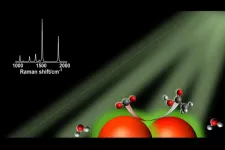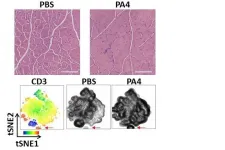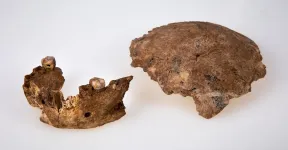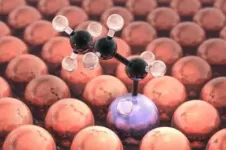Light-harvesting nanoparticle catalysts show promise in quest for renewable carbon-based fuels
2021-06-24
(Press-News.org) CHAMPAIGN, Ill. -- Researchers report that small quantities of useful molecules such as hydrocarbons are produced when carbon dioxide and water react in the presence of light and a silver nanoparticle catalyst. Their validation study - made possible through the use of a high-resolution analytical technique - could pave the way for CO2-reduction technologies that allow industrial-scale production of renewable carbon-based fuels.
The study, led by University of Illinois Urbana-Champaign chemistry professor Prashant Jain, probes chemical activity at the surface of silver nanoparticle catalysts under visible light and uses carbon isotopes to track the origin and production of these previously undetected chemical reactions. The findings are published in the journal Nature Communications.
Sunlight-driven conversion of CO2 and water into energy-dense multicarbon compounds is a viable technology for renewable energy generation and chemical manufacturing. Because of this, researchers have been on the hunt for synthetic catalysts that facilitate large-scale CO2 reduction into multicarbon molecules, the study reports.
"Industrial-level catalytic chemical reactions are usually tested and optimized on the basis of the bulk profile of the final products," Jain said. "But there are chemical species formed at the intermediate stages of such reactions, on the surface of the catalysts, that might be too scarce to detect and measure using conventional methods but are fundamental signifiers of how a catalyst functions."
In the lab, Jain's team used a specially outfitted Raman spectroscope to detect and identify single molecules formed at the surface of individual silver nanoparticles. By isolating a single nanoparticle on which the chemical reactions progress, the researchers can use a highly focused laser to excite molecules forming on the catalyst surface to create a spectral signal that identifies the molecules formed in discrete, elementary steps of the overall chemical process.
"I like to think of this work in terms of a story," Jain said. "There is an overall theme to a story, which is the reduction of CO2. The main characters are CO2, H2O, silver nanoparticles, carbon monoxide and hydrogen ions, for example. But there are also some more minor but very interesting characters like butanol, acetate and oxalic acid that help tell the back story of the main characters. And sometimes, the minor characters are a lot more interesting than the major ones."
Sometimes minor characters can come with some unintended players, Jain said. To ensure that the intermediate carbon-based molecules the researchers detected are a result of the CO2 reduction process and not contamination, they used CO2 containing only carbon-13 isotope, which makes up only 1.1% of the carbon on Earth.
"Using carbon-13 to trace the reaction pathways allowed us to confirm that any hydrocarbons measured were there as a result of the CO2 we intentionally added in the reaction vessel, and not accidentally introduced via contamination of the silver nanoparticles or later during the analysis process," Jain said. "Carbon-13 is rare, so if we were to detect it in our reaction products, we would know it was the result of the light-driven conversion of CO2 and C-C bond formation."
The scale of multicarbon molecule formation by using silver nanoparticle catalysts remains very small at this stage of the research, Jain said. However, researchers can concentrate on developing improved synthetic catalysts and scaling up for industrial production, now that the promise of light-harvesting nanoparticles has been revealed.
INFORMATION:
The National Science Foundation and the Energy and Biosciences Institute through the EBI-Shell program supported this stud
U. of I. graduate researcher Dinumol Devasia conducted the studies with contributions from former postdoctoral researcher Andrew J. Wilson, former graduate student Varun Mohan and current graduate student Jaeyoung Heo. Jain also is affiliated with physics, the Materials Research Laboratory and the Beckman Institute for Advanced Science and Technology at Illinois.
Editor's notes:
To reach Prashant Jain, call 217-333-3417; email jain@illinois.edu.
The paper "A rich catalog of C-C bonded species formed in CO2 reduction on a plasmonic photocatalyst" is available online and from the Illinois News Bureau. DOI: 1038/s41467-021-22868-9.
[Attachments] See images for this press release:

ELSE PRESS RELEASES FROM THIS DATE:
2021-06-24
By Benjamin Boettner
(Boston) - Muscular dystrophies are a group of genetic diseases that lead to the progressive loss of muscle mass and function in patients, with the incurable Duchenne Muscular Dystrophy (DMD), which affects all the body's muscles primarily in boys, being particularly severe. DMD can be caused by more than 7,000 unique mutations in the largest gene of the human genome, which encodes a central protein in muscle fibers. While this astounding number of mutations all variably block muscle function, the affected muscles share another common feature - chronic inflammation.
As chronic inflammation ...
2021-06-24
Scientists need to focus on tangible efforts to boost equity, diversity and inclusion in citizen science, researchers from North Carolina State University argued in a new perspective.
Published in the journal Science, the perspective is a response to a debate about rebranding "citizen science," the movement to use crowdsourced data collection, analysis or design in research. Researchers said that while the motivation for rebranding is in response to a real concern, there will be a cost to it, and efforts to make projects more inclusive should go deeper than that. Their recommendations speak to a broader discussion about how to ensure science is responsive to the needs of a diverse audience.
"At its heart, citizen science is a system of knowledge production ...
2021-06-24
Parents of children with the most complex medical conditions are more likely to report poor or fair mental health and struggle to find community help, according to a study completed by researchers at University of Rochester Medical Center (URMC) and Golisano Children's Hospital. The study was published in Pediatrics, the journal of the American Academy of Pediatrics (AAP).
The study, "A National Mental Health Profile of Parents of Children with Medical Complexity," examined parent-reported data from the National Survey of Children's Health, and compared three groups: households of children with medical complexity (CMC), households of noncomplex children with special health care needs, and households of children ...
2021-06-24
Not all stresses are created equal, according to a pair of new studies, which shows that distinct ubiquitination patterns underlie cell recovery following different environmental stressors. Eukaryotic cells respond to environmental stressors - such as temperature extremes, exposure to toxins or damage, for example - through adaptive programs that help to ensure their survival, including the shutdown of key cellular processes. These responses are often associated with the formation of stress granules (SGs) - dense cytoplasmic aggregations of proteins and RNA - as well as with ...
2021-06-24
Although the Antibody Mediated Prevention (AMP) study that launched in 2016 failed to show significant efficacy in a pair of clinical trials, Denis Burton argues in a Perspective that the AMP study's results represent a landmark in AIDS research; they show - for the first time - that a broadly neutralizing antibody (bnAb) can protect humans against exposure to some strains of HIV. According to Burton, the AMP study's data - despite not showing a significant difference between the numbers of infected individuals in the treated groups versus those in the placebo groups - still have tremendous implications for future HIV vaccine design and passive bnAb use strategies. The AMP study evaluated the immunotherapeutic ...
2021-06-24
BINGHAMTON, N.Y. -- Analysis of recently discovered fossils found in Israel suggest that interactions between different human species were more complex than previously believed, according to a team of researchers including Binghamton University anthropology professor Rolf Quam.
The research team, led by Israel Hershkovitz from Tel Aviv University, published their findings in Science, describing recently discovered fossils from the site of Nesher Ramla in Israel. The Nesher Ramla site dates to about 120,000-140,000 years ago, towards the very end of the Middle Pleistocene time period.
The human fossils were found by Dr. Zaidner of ...
2021-06-24
Researchers at Tufts University, University College London (UCL), Cambridge University and University of California at Santa Barbara have demonstrated that a catalyst can indeed be an agent of change. In a study published today in Science, they used quantum chemical simulations run on supercomputers to predict a new catalyst architecture as well as its interactions with certain chemicals, and demonstrated in practice its ability to produce propylene - currently in short supply - which is critically needed in the manufacture of plastics, fabrics and other chemicals. The improvements have potential for highly efficient, "greener" chemistry with a lower carbon footprint.
The demand for propylene is ...
2021-06-24
The discovery of a new Homo group in this region, which resembles Pre-Neanderthal populations in Europe, challenges the prevailing hypothesis that Neanderthals originated from Europe, suggesting that at least some of the Neanderthals' ancestors actually came from the Levant.
The new finding suggests that two types of Homo groups lived side by side in the Levant for more than 100,000 years (200-100,000 years ago), sharing knowledge and tool technologies: the Nesher Ramla people who lived in the region from around 400,000 years ago, and the Homo sapiens who arrived later, some 200,000 years ago.
The new discovery also gives clues about a mystery in human evolution: How did genes of Homo sapiens penetrate the Neanderthal population that had presumably lived in Europe long before ...
2021-06-24
Mythological nymphs reincarnate as a group of corn smut proteins to launch a battle on maize immunity. One of these proteins appears to stand out among its sister Pleiades, much like its namesake character in Greek mythology. The research carried out at GMI - Gregor Mendel Institute of Molecular Plant Biology of the Austrian Academy of Sciences - is published in the journal PLOS Pathogens.
Pathogenic organisms exist under various forms and use diverse strategies to survive and multiply at the expense of their hosts. Some of these pathogens are termed "biotrophic", as they are parasites that maintain their hosts alive. These biotrophic pathogens deregulate physiological processes in their hosts by suppressing their immune defenses and favoring disease development. ...
2021-06-24
INDIANAPOLIS -- A first-of-its-kind large-scale study of vegetation growth in the Northern Hemisphere over the past 30 years has found that vegetation is becoming increasingly water-limited as global temperatures increase.
The results are significant since vegetation is one of the biggest factors when it comes to controlling water and carbon cycling across Earth, which influences global temperatures. The work by IUPUI and Indiana University Bloomington researchers Wenzhe Jiao, END ...
LAST 30 PRESS RELEASES:
[Press-News.org] Light-harvesting nanoparticle catalysts show promise in quest for renewable carbon-based fuels





